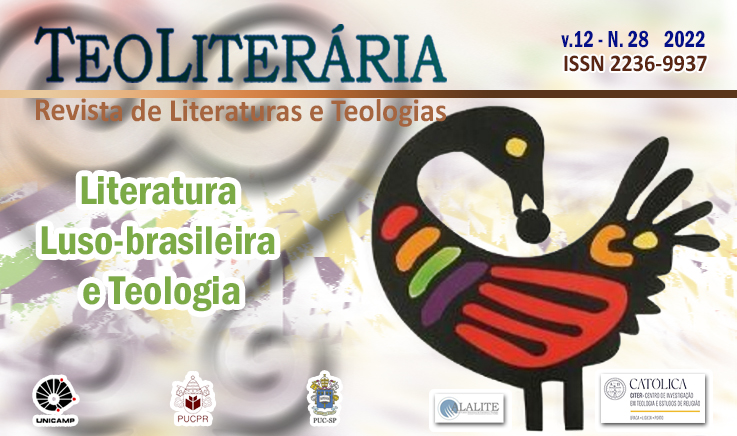The Narrative of Creation in the verses of the woman who deceived the Devil
DOI:
https://doi.org/10.23925/2236-9937.2022v28p81-110Keywords:
Cordel, Devil, Exorcism, Paradise, TheopoeticsAbstract
This article presents an approximation between “literature de cordel” and the biblical text of Genesis 1 to 2, in view of a rereading of the narrative of Creation in the verses of The Woman who deceived the Devil, by Manoel D’Almeida Filho. The perspective is of a possible intertextuality, as a kind of dialogue between the textual constructions of the Bible and cordel. Theopoetics directs this article, considering the understanding of Antônio Manzatto and José Carlos Barcellos as the background for the approximation between theology and literature. The methodology is the bibliographical research and the analytical reading of the books, promoting the understanding of the cordelistic imagination about Creation in the seven mandates of Maria da Conceição and the comparison with the biblical narrative. The poet puts into verses the dream of a good place to live, a paradise without suffering and inequality, where there is no room for evil nor for the Devil.
References
ACADEMIA BRASILEIRA DE LITERATURA DE CORDEL. Disponível em: http://www.ablc.com.br/. Acesso em: 20.05. 2019.
ALMEIDA FILHO, Manoel d’. A mulher que enganou o Diabo. São Paulo. Editora Luzeiro Limitada, 1986. .
BARCELLOS, José Carlos. O drama da salvação: Espaço Autobiográfico e Experiência Cristã em Julien Green. Juiz de Fora: Editora Subíaco, 2008.
BARCELLOS, José Carlos. Literatura e teologia: perspectivas teórico-metodológicas no pensamento católico contemporâneo. Numen: revista de estudos e pesquisa da religião da Universidade Federal de Juiz de Fora, Juiz de Fora, v. 3, n. 2, p. 9-30, jul./ dez. 2000. Disponível em: https://numen.ufjf.emnuvens.com.br/numen/article/view/852/737. Acesso em: 24.05. 2020.
CANTARELA, A. G. “Modelos de Leitura do diálogo entre religião e literatura”. In: Anais do V Congresso da ANPTECRE “Religião, Direitos Humanos e Laicidade”. PUC PR: Curitiba, 2015, p. 107-114. Disponível em: https://1library.org/document/zle174lq-modelos-de-leitura-do-dialogo-entre-religiao-literatura.html. Acesso em: 02.05.2022.
FUNDAÇÃO CASA RUI BARBOSA. Disponível em: http://www.casaruibarbosa.gov.br/cordel/acervo.html. Acesso em: 20.05. 2019.
GÊNESIS. In: Bíblia Católica Online. Capítulos 1 – 2. Disponível em: https://www.bibliacatolica.com.br/biblia-ave-maria/genesis/. Acesso em: 20.05. 2019.
MANZATO, Antônio. Teologia e Literatura: reflexão teológica a partir da antropologia contida nos romances de Jorge Amado. São Paulo: Edições Loyola, 1994.
MATOS, Edilene. O imaginário na literatura de cordel. Salvador: Edições Macunaíma, 1986.
NAVES, Alair Matilde. Representações do diabo no cordel de Manoel D’almeida Filho. Dissertação (Mestrado). Belo Horizonte: Departamento de ciências da Religião da Pontifícia Universidade Católica de Minas Gerais, 2019.
Published
How to Cite
Issue
Section
License
Copyright (c) 2021 Teoliteraria - Journal of Literatures and Theologies (On Line) ISSN 2236-9937

This work is licensed under a Creative Commons Attribution 4.0 International License.
TeoLiteraria – Journal of Literatures and Theologies owns the copyright of all published material. The whole reproduction of the articles of this Journal in other publications or for any other purpose, by any means, requires a written permission of the editor of this journal. Partial reproductions of articles (abstracts, more than 500 words text, tables, figures and other illustrations) must have a permission written by the publisher and the authors.

